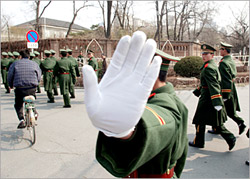Chinese-controlled Kashmir
Few people know that Beijing is an interested party in Kashmir but it controls 20 percent of the strategic region.
In the west, the Kashmir dispute that has led to thousands of deaths is regarded as a problem between India and Pakistan. It is often forgotten that 20 percent of the whole of Kashmir is controlled by neither – and is administered by the region’s other nuclear power. China has long been involved in a triangular relationship with Pakistan and India, but remains a silent third party to the dispute over Kashmir.
 |
|
The Chinese military keeps a low profile in |
Aksai Chin is for the most part an ice desert that Indian prime minister Nehru described before the Chinese invasion as barren and desolate “where not a blade of grass grows”; nevertheless its share of the disputed Kashmir region is substantial.
While India and Pakistan continue to mass troops on either side of the line of control, China can observe the unstable situation with little need to get itself involved. Bringing international attention to its occupation of the Tibetan plateau, of which Aksai Chin is part, is not in its interest.
Chinese foreign policy in recent years has been to publicly distance itself from both sides with regard to the dispute, though Beijing traditionally supported Pakistan against India during the Cold War. Now it tries to develop better relations with India – the resumption of flights between the two countries last year was evidence of this. Nevertheless China has a strategic interest in the survival of Pakistan and it will not want to see it drawn into a war which it cannot win – the reason why it secretly helped Pakistan to develop nuclear weapons.
The war in 1962 ended with China seizing about 38,000 square kilometres of territory that had been under Indian administration, and annexing another 5,180 sq km of northern Kashmir that Pakistan had administered until the 1963 pact. However, the Indian government does not recognise the border agreement the Chinese reached with Pakistan over the section of Kashmir under Pakistani control.
From a geopolitical point of view, China has consistently sought to constrain Indian power and confine it to the region of South Asia. In addition to the strategic interest in not having to confront a single powerful neighbour to the south of the Himalayas, China is also concerned by Indian claims to the whole of Kashmir and its interest in Tibet: India still hosts the Dalai Lama and his government in exile.
China has not only contained India by strengthening Pakistan, but it has refused to recognise India’s claims to Sikkim and encouraged Bangladesh (then East Pakistan) to stand up to India. In the 1965 Indo-Pakistan war, China went so far as to threaten to open a second front against India. But its main support has been expressed through the supply of arms. Once Pakistan was divided in 1971, it became no match for Indian strength.
Aksai Chin’s remoteness should not lead to its dismissal as unimportant. The 1962 war was fought for several reasons. The Chinese approach is determined by three broad considerations; border issues, geopolitics and international strategy, according to Professor Michael Yahuda of the London School of Economics.
Among broader considerations, China is quite aware that both Pakistan and India are capable of continuing their military standoff. China can use India’s desire to control the whole of Kashmir as a bargaining tool. After all, India and China have made slow progress in resolving differences over their shared 4,500-km Himalayan frontier. A good portion of it, 3,268 km, still falls into the three disputed sectors. Their disputes over the western and eastern sectors are particularly sensitive and have prevented better relations for years.
Despite the occasional breakthrough such as the exchange of approved maps in minor disputed sectors, as long as India calls for the return of areas of Kashmir China can counterclaim for large parts of the northeastern Indian states of Sikkim and Arunachal Pradesh.
The longer the Kashmir dispute continues however, the more unlikely it is that China will compromise; it has already built some significant infrastructure in Aksai Chin during the last 40 years. Now an all-weather highway links remote western Tibet (Xizang province as China calls it) from Lhasa to Xinjiang province’s Kashgar, a vital logistical route. Military trucks ply the highway which is largely 4,000 metres above sea level making it one of the highest and coldest roads in the world.
India and China were rivals in the Cold War era. From the 1970s this was reflected in eventual American support for China and the Soviet bloc’s support for India. Since the end of the Cold War, however, India and China have substantially reduced their enmity, finding reasons to co-operate and in some ways co-ordinate their dealings with the world’s sole superpower, the United States.
After 11 September matters became more complicated. Both China and India have drawn closer to the US, India perhaps moreso than China. But China is anxious to avoid trouble with the US at a time of leadership succession, and at a time when it has to adjust to the terms of entry to the World Trade Organisation. Moreover, China has benefited to an extent from the “war on terror”, which has enabled it to suppress resistance to its rule in its Central Asian province of Xinjiang. Nevertheless the Chinese eye warily the American military presence in Central Asia and Afghanistan.
From a Chinese point of view the renewing internationalisation of the Kashmir problem has come at a most difficult time, Chinese displeasure with Pakistan in raising tension in the region surfaced when Beijing opposed the Pakistani incursion into Kargil in 1999. It was one of the first occasions that the Chinese withheld support from Pakistan. China has also noticeably not joined Islamabad in calling for an international settlement of the Kashmiri issue, but has implicitly sided with New Delhi in calling for dialogue between the two.